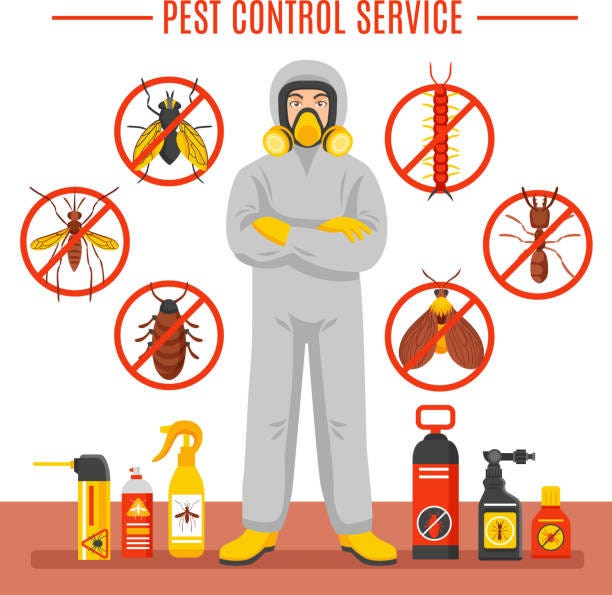Relied On A1 Exterminator Charlotte NC - Comprehensive Pest Solutions
Wiki Article
Bed Pest Therapy Breakdown: Comparing Chemical Vs. Non-Chemical Solutions
In the realm of bug control, particularly when dealing with the consistent problem of bed bugs, the selection in between chemical and non-chemical therapy remedies can be an essential one. Both techniques offer distinctive benefits and drawbacks, affecting variables such as effectiveness, safety considerations, and overall expense. By analyzing the nuanced information of each method, a clearer understanding of which path to seek in resolving a bed insect invasion can be attained.Effectiveness of Chemical Treatments
Chemical treatments for bed bug invasions have actually been extensively identified for their powerful and fast efficiency in getting rid of these pests. When taking into consideration the performance of chemical therapies, it is essential to comprehend that they can offer a thorough and quick service to a bed pest issue.Additionally, chemical therapies have the benefit of supplying recurring results, suggesting that they can proceed to remove bed pests also after the preliminary application. This residual activity is specifically valuable in combating any prospective re-infestations. Furthermore, the fast activity of chemical treatments can bring relief to individuals dealing with extreme bed pest infestations, enabling them to gain back control of their home promptly.
Security Worries With Chemical Solutions
One essential aspect that requires careful consideration when utilizing chemical solutions for bed bug therapy is ensuring the safety of residents and the environment. Exposure to certain chemicals utilized in bed bug therapies can lead to breathing issues, skin irritation, or other negative responses, specifically in individuals with pre-existing problems or sensitivities.Furthermore, the environmental influence of chemical solutions is another substantial consideration. Some pesticides used in bed pest treatments may be dangerous to beneficial bugs, wildlife, and ecosystems if they seep into the soil or water systems. It is necessary to utilize chemical treatments sensibly, adhering to safety guidelines, and taking into consideration less toxic choices to minimize these dangers and guarantee the efficient and secure administration of bed bug invasions.
Benefits of Non-Chemical Methods
Considering the potential security issues and ecological impact connected with chemical solutions for bed bug therapy, discovering non-chemical methods presents an appealing option with numerous unique advantages. Non-chemical approaches provide a more secure option for houses, especially those with individuals, pet dogs, or youngsters delicate to extreme chemicals. These strategies remove the dangers of direct exposure to toxic materials, minimizing the capacity for damaging wellness results. Additionally, non-chemical therapies are eco-friendly, as they do not add to air or water contamination, making them a lasting selection for pest control.Additionally, non-chemical solutions can be reliable in targeting bed bugs, including hard-to-reach areas where chemical therapies might not permeate. Approaches such as warm treatment, vacuuming, steam cleaning, and mattress coverings provide complete removal without using dangerous chemicals. Moreover, non-chemical approaches can be much less disruptive, calling for marginal prep work and enabling quicker reentry into treated areas. Generally, going with non-chemical bed pest treatment techniques not just prioritizes safety and security and environmental defense yet also ensures effective and thorough parasite control.
Limitations of Non-Chemical Treatments

In addition, non-chemical treatments often call for numerous applications to achieve successful obliteration. This can be lengthy and may not always assure complete elimination of all bed insects and their eggs, especially in concealed or hard-to-reach locations.
Furthermore, the success of non-chemical treatments heavily depends on correct execution and thoroughness, which can be testing for individuals without specialist competence. Poor application of non-chemical techniques may lead to insufficient obliteration, causing relentless infestations and the need for additional treatments.
For that reason, while non-chemical therapies have their benefits, it is important to acknowledge these restrictions and consider them when establishing the most effective technique for handling bed pest problems.
Cost Comparison: Chemical Vs. Non-Chemical Options
Offered the limitations related to non-chemical treatments, a necessary element to examine in the context of bed bug management is the price comparison between chemical and non-chemical choices. Chemical treatments typically include the application of insecticides by specialists, which can vary from $250 to $900 per space, depending on the seriousness of the infestation and the dimension of the area to be dealt with. On the other hand, non-chemical therapies like warm treatment or steam can be more costly, with prices varying from $1,000 to $6,000 for an entire home. While the first price of chemical treatments may appear lower, multiple treatments might be required to totally get rid of the problem, possibly enhancing the general expense. On the various other hand, non-chemical alternatives may supply a more sustainable and eco-friendly remedy, although they can be cost-prohibitive for some individuals. Eventually, when thinking about the cost of bed bug therapy alternatives, it is necessary to evaluate the in advance expenses against the effectiveness and long-term sustainability of the picked method.Conclusion

Taking into consideration the potential safety problems and ecological impact associated with chemical services for bed pest treatment, discovering non-chemical methods provides an encouraging option with several unique advantages.Provided the restrictions associated with non-chemical therapies, an essential facet to assess in the context of bed pest administration is the price comparison between chemical and non-chemical choices. In contrast, non-chemical therapies like warmth treatment or steam can be extra expensive, with costs ranging from $1,000 to $6,000 for an entire home. While the first price of chemical treatments may seem reduced, several therapies may be required to completely eliminate the problem, potentially increasing the general cost.In final thought, when contrasting chemical and non-chemical bed pest therapy options, it is crucial to consider performance, security, advantages, restrictions, and expense.
Report this wiki page